Urbanization and Cultural Industry Correlation: An Empirical Analysis from China
Abstract
1. Introduction
1.1. A New Dimension of Sustainable Development: The Cultural Industry
- -
- Low Carbon Emission: Compared to heavy industry and other material-intensive industries, the cultural industry generally has a lower carbon footprint, as activities such as design, programming, writing, music production, and filmmaking do not produce significant carbon emissions.
- -
- Non-Reliance on Finite Resources: Unlike mining or agriculture, the cultural industry does not directly depend on finite natural resources. Although the production of CDs, books, or film equipment may require material resources, the core value lies in creative content not the physical medium.
- -
- Promotion of Sustainable Development Concepts: The cultural industry, particularly the media and entertainment sectors, has a substantial influence and can convey messages about environmental protection and sustainable development to the public.
- -
- Driving Innovation: The cultural industry encourages innovative thinking and creative approaches that can be applied to broader fields, including green technologies and sustainable solutions.
- -
- Promoting a Circular Economy: Cultural products such as digital content, music, films, and books can be consumed repeatedly without depleting resources or generating waste.
- -
- Providing Green Jobs: The cultural industry offers many employment opportunities, which are generally more environmentally friendly and sustainable compared to traditional “blue-collar” jobs.
1.2. A Focus of Modern Development: Urbanization
- -
- Population Migration: The most direct manifestation of urbanization is the migration of rural populations to cities, leading to increased urban populations and urban area expansion.
- -
- Economic Structure Transformation: As urbanization progresses, the economic structure shifts from agriculture-dominated to industry and service-dominated, with cities becoming crucial engines of economic growth.
- -
- Social Structure Changes: During urbanization, social structures become more complex with more refined social divisions of labor and a growing middle class and intellectual community.
- -
- Lifestyle Changes: Urbanization brings about modernized lifestyles with urban residents adopting different patterns of consumption, leisure, and social activities.
- -
- Urban Space Expansion: Urbanization is accompanied by the enlargement of urban areas, including the expansion of city boundaries and construction of urban infrastructure.
- -
- Environmental and Sustainable Development Issues: Urbanization intensifies environmental pressures, such as air pollution, water scarcity, and waste management challenges, making sustainable development a critical issue in urbanization processes.
1.3. Research Objectives
2. Literature Review
2.1. Research on the Cultural Industry
- Cultural Services Industry: This primarily includes sectors such as photography, entertainment services, sports, education, arts, publishing, library services, public cultural services, cultural heritage services, cultural brokerage and agency services, broadcasting, film, television, and other cultural services not classified under the aforementioned categories.
- Cultural Manufacturing Industry: Comprises companies involved in manufacturing musical instruments, amusement devices, entertainment goods, toys, cultural products, printing, and other cultural manufacturing activities.
- Cultural Wholesale and Retail Industry: Involves the sale and trade of cultural products, including art dealing, cultural assets management, audiovisual products, and gift sales.
2.2. Research on Urbanization
3. Materials and Methods
3.1. Research Procedure
- -
- Measure and evaluate the Chinese cultural industry and conduct research analysis.
- -
- Collect, select, and analyze relevant data representing China’s new urbanization.
- -
- Investigate the correlation between the two.
- -
- Discuss and draw conclusions and recommendations.
3.2. Methods
3.3. Materials
4. Results
4.1. Construction of a Global SBM Model for Assessing the Economic Efficiency of China’s Cultural Industry, 2018–2021
- -
- “Mean value of TE” represents the average efficiency score under the assumption of constant returns to scale for the 31 provinces and municipalities.
- -
- “Mean value of PTE” represents the average efficiency score under the assumption of variable returns to scale for the 31 provinces and municipalities.
- -
- “Mean value of SE” represents the average scale efficiency score for the 31 provinces and municipalities.
- -
- “Number of CRS” indicates the number of provinces and municipalities with constant returns to scale.
- -
- “Number of IRS” indicates the number of provinces and municipalities with increasing returns to scale.
- -
- “Number of DRS” indicates the number of provinces and municipalities with decreasing returns to scale.
4.2. Construction of a Tobit Regression Model for China’s Cultural Industry Economic Efficiency
- -
- Proportion of urban population (%): This variable is generally considered the most representative of urbanization levels in various provinces and cities with data sourced from the China Statistical Yearbook.
- -
- Percentage of assets of cultural industry enterprises above scale (%): This represents the degree of scale of cultural industry-related enterprises in each province and city. Typically, provinces and cities with higher degrees of urbanization have a higher proportion of total assets represented by large-scale enterprises. This is calculated as the total assets of large-scale cultural and related industry enterprises divided by the total assets of all cultural industry enterprises in the province or city. Large-scale enterprises are defined as industrial enterprises with an annual main business income of 20,000,000 yuan or more, wholesale enterprises with an annual main business income of 20,000,000 yuan or more, retail enterprises with an annual main business income of 5,000,000 yuan or more, and service enterprises with an annual business income of 10,000,000 yuan or more, with data from the China Cultural Statistics Yearbook.
- -
- Per capita expenditure on culture and recreation as a percentage (%): This is calculated as the annual per capita expenditure on culture and entertainment as a percentage of total per capita expenditure. Numerous studies indicate that urbanization promotes cultural and recreational spending, which constitutes a higher percentage of total spending [57]. Data are sourced from the China Statistical Yearbook and the China Cultural Statistics Yearbook.
- -
- -
- Per capita disposable income (10,000 CNY): This represents the affluence level of each province and city, which is also a positive impact of urbanization. Data are sourced from the China Statistical Yearbook.
- -
- Tax-to-asset ratio (%): This represents the tax burden of the cultural industry in each province and city, which is calculated as the total cultural industry-related tax revenue divided by the total assets of cultural industry enterprises in the province or city. Data are sourced from the China Statistical Yearbook and the China Tax Statistics Yearbook.
- -
- Degree of financial support (%): This represents the level of provincial and city government support for the cultural industry, which is calculated as the expenditure for Culture, Sport, and Media divided by the general public budget expenditure of the province or city. Data are sourced directly from the yearbook. Note that these data include expenditures for sports, and since specific data for sports expenditure are unavailable and cannot be separated, using expenditure for Culture, Sport, and Media directly impacts the precision of the Tobit model. However, since the data from all 31 provinces and cities include sports expenditures, it does not significantly impact the conclusions regarding the existence of significant correlations, although it reduces the precision of the Tobit model.
5. Discussion
5.1. Positive Trends in the Economic Efficiency of China’s Cultural Industry across 31 Provinces
5.2. Analysis of Determinants Affecting the Economic Efficiency of China’s Cultural Industry
5.3. Analysis of Scale and Efficiency in China’s Cultural Industry: A Case Study of Jiangsu Province
5.4. Jiangsu’s Cultural Industry Is Experiencing Diminishing Returns to Scale
5.5. Analyzing Jiangsu’s Cultural Industry through the Tobit Model
6. Conclusions, Contributions and Shortcomings
6.1. Conclusions
6.2. Contributions and Shortcomings
6.2.1. Methodological Contributions
6.2.2. Content Contributions
6.2.3. Methodological Contributions
6.2.4. Limitations and Future Research Directions
Author Contributions
Funding
Institutional Review Board Statement
Informed Consent Statement
Data Availability Statement
Conflicts of Interest
References
- Brocchi, D. The cultural dimension of sustainability. In Religion and Dangerous Environmental Change: Transdisciplinary Perspectives on the Ethics of Climate and Sustainability; LIT Verlag Münster: Münster, Germany, 2010; p. 145. [Google Scholar]
- Duxbury, N.; Kangas, A.; De Beukelaer, C. Cultural policies for sustainable development: Four strategic paths. Int. J. Cult. Policy 2017, 23, 214–230. [Google Scholar] [CrossRef]
- Nurse, K. Culture as the fourth pillar of sustainable development. Small States Econ. Rev. Basic Stat. 2006, 11, 28–40. [Google Scholar]
- Klein, M.; Gutowski, P.; Gerlitz, L.; Gutowska, E. Creative and Culture Industry in Baltic Sea Region Condition and Future. Sustainability 2021, 13, 4239. [Google Scholar] [CrossRef]
- Liu, Y. Three Considerations for the Development of the Cultural Industry under the Goal of Building a Strong Cultural Nation. 19 January 2021. Available online: http://icit.ruc.edu.cn/zxdt/c240785f1a444e16b74fe3ade55f5ff8.htm (accessed on 1 June 2024).
- Banks, A.S.; Carr, D.L. Urbanization and modernization: A longitudinal analysis. Stud. Comp. Int. Dev. 1974, 9, 26–45. [Google Scholar] [CrossRef] [PubMed]
- Rössel, J. Modernization. In Encyclopedia of Global Studies; Helmut, K.A., Mark, J., Victor, F., Eds.; Sage: Thousand Oaks, CA, USA, 2012; pp. 1178–1183. [Google Scholar]
- Marsh, R.M. Modernization theory, then and now. Comp. Sociol. 2014, 13, 261–283. [Google Scholar] [CrossRef]
- Li, Y.; Zhu, K.; Yu, R.; Li, X.; Xian, B.T.S. Synchronous Development Strategy of China’s New Four Modernizations: An Analysis Based on Interactive Mode. IEEE Access 2023, 11, 53344–53358. [Google Scholar] [CrossRef]
- Henderson, V. Urbanization in Developing Countries. World Bank Res. Obs. 2002, 17, 89–112. [Google Scholar] [CrossRef]
- Ravallion, M.; Chen, S.; Sangraula, P. New evidence on the urbanization of global poverty. Popul. Dev. Rev. 2007, 33, 667–701. [Google Scholar] [CrossRef]
- Humbal, A.; Chaudhary, N.; Pathak, B. Urbanization trends, climate change, and environmental sustainability. In Climate Change and Urban Environment Sustainability; Springer: Berlin/Heidelberg, Germany, 2023; pp. 151–166. [Google Scholar]
- Li, J. Culture and tourism-led peri-urban transformation in China–The case of Shanghai. Cities 2020, 99, 102628. [Google Scholar] [CrossRef]
- Liang, S.; Wang, Q. Cultural and creative industries and urban (re) development in China. J. Plan. Lit. 2020, 35, 54–70. [Google Scholar] [CrossRef]
- Vila, S.F.; Miotto, G.; Rodríguez, J.R. Cultural Sustainability and the SDGs: Strategies and Priorities in the European Union Countries. Eur. J. Sustain. Dev. 2021, 10, 73. [Google Scholar] [CrossRef]
- d’Orville, H. The relationship between sustainability and creativity. Cadmus 2019, 4, 65–73. [Google Scholar]
- State Council of China. The State Council Executive Meeting Discusses and Adopts the Revitalization Plan for the Cultural Industry. 2009. Available online: https://www.gov.cn/ldhd/2009-07/22/content_1371926.htm (accessed on 1 September 2023).
- State Council of China. Outline of the National Cultural Development and Reform Plan for the 13th Five-Year Plan Period. 2017. Available online: https://www.gov.cn/gongbao/content/2017/content_5194886.htm (accessed on 1 September 2023).
- Shan, S.-l. Chinese cultural policy and the cultural industries. City Cult. Soc. 2014, 5, 115–121. [Google Scholar] [CrossRef]
- Vlassis, A. Soft power, global governance of cultural industries and rising powers: The case of China. Int. J. Cult. Policy 2016, 22, 481–496. [Google Scholar] [CrossRef]
- Ju, H. Research on the efficiency measurement of Chinese cultural manufacturing industry based on DEA method. Int. J. Front. Sociol. 2019, 1, 32–42. [Google Scholar]
- Williamson, J.G. Chapter 11 Migration and urbanization. In Handbook of Development Economics; Elsevier: Amsterdam, The Netherlands, 1988; Volume 1, pp. 425–465. [Google Scholar]
- Henderson, J.V. Chapter 24—Urbanization and Growth. In Handbook of Economic Growth; Aghion, P., Durlauf, S.N., Eds.; Elsevier: Amsterdam, The Netherlands, 2005; Volume 1, pp. 1543–1591. [Google Scholar]
- Ritchie, H.; Roser, M. Urbanization. Our World in Data. 2018. Available online: https://ourworldindata.org/urbanization (accessed on 1 July 2024).
- Phillips, D.R. Urbanization and human health. Parasitology 1993, 106, S93–S107. [Google Scholar] [CrossRef] [PubMed]
- Smart, A.; Smart, J. Urbanization and the global perspective. Annu. Rev. Anthropol. 2003, 32, 263–285. [Google Scholar] [CrossRef]
- Seto, K.C.; Sánchez-Rodríguez, R.; Fragkias, M. The new geography of contemporary urbanization and the environment. Annu. Rev. Environ. Resour. 2010, 35, 167–194. [Google Scholar] [CrossRef]
- State Council of China. National New Urbanisation Plan (2014–2020). 2014. Available online: https://www.gov.cn/zhengce/2014-03/16/content_2640075.htm (accessed on 25 January 2024).
- State Council of China. Key Tasks for the Construction of New Urbanization in 2019. 2019. Available online: https://www.gov.cn/xinwen/2019-04/08/content_5380457.htm (accessed on 1 April 2024).
- Chan, K.W. Fundamentals of China’s urbanization and policy. China Rev. 2010, 10, 63–93. [Google Scholar]
- Tan, Y.; Xu, H.; Zhang, X. Sustainable urbanization in China: A comprehensive literature review. Cities 2016, 55, 82–93. [Google Scholar] [CrossRef]
- Li, Y.; Jia, L.; Wu, W.; Yan, J.; Liu, Y. Urbanization for rural sustainability–Rethinking China’s urbanization strategy. J. Clean. Prod. 2018, 178, 580–586. [Google Scholar] [CrossRef]
- Chaolin, G.U.; Liya, W.U.; Cook, I. Progress in research on Chinese urbanization. Front. Archit. Res. 2012, 1, 101–149. [Google Scholar] [CrossRef]
- Guan, X.; Wei, H.; Lu, S.; Dai, Q.; Su, H. Assessment on the urbanization strategy in China: Achievements, challenges and reflections. Habitat Int. 2018, 71, 97–109. [Google Scholar] [CrossRef]
- Ying, D.; Wu, W. Urbanization Is the Irresistible Trend of Development in China (Introduction). In A Study of China’s Urban-Rural Integration Development; Ying, D., Wu, W., Eds.; Springer Nature Singapore: Singapore, 2022; pp. 1–27. [Google Scholar]
- Schmookler, J. The changing efficiency of the American economy, 1869–1938. Rev. Econ. Stat. 1952, 34, 214–231. [Google Scholar] [CrossRef]
- Mundaca, L.; Neij, L.; Worrell, E.; McNeil, M. Evaluating energy efficiency policies with energy-economy models. Annu. Rev. Environ. Resour. 2010, 35, 305–344. [Google Scholar] [CrossRef]
- Bukarica, V.; Tomšić, Ž. Energy efficiency policy evaluation by moving from techno-economic towards whole society perspective on energy efficiency market. Renew. Sustain. Energy Rev. 2017, 70, 968–975. [Google Scholar] [CrossRef]
- Paul, C.; Nehring, R.; Banker, D.; Somwaru, A. Scale economies and efficiency in US agriculture: Are traditional farms history? J. Product. Anal. 2004, 22, 185–205. [Google Scholar] [CrossRef]
- Reza Anik, A.; Rahman, S.; Sarker, J.R. Five decades of productivity and efficiency changes in world agriculture (1969–2013). Agriculture 2020, 10, 200. [Google Scholar] [CrossRef]
- Charnes, A.; Cooper, W.W.; Rhodes, E. Measuring the efficiency of decision making units. Eur. J. Oper. Res. 1978, 2, 429–444. [Google Scholar] [CrossRef]
- Banker, R.D.; Charnes, A.; Cooper, W.W. Some models for estimating technical and scale inefficiencies in data envelopment analysis. Manag. Sci. 1984, 30, 1078–1092. [Google Scholar] [CrossRef]
- Tone, K. A slacks-based measure of efficiency in data envelopment analysis. Eur. J. Oper. Res. 2001, 130, 498–509. [Google Scholar] [CrossRef]
- Ohsato, S.; Takahashi, M. Management efficiency in Japanese regional banks: A network DEA. Procedia-Soc. Behav. Sci. 2015, 172, 511–518. [Google Scholar] [CrossRef]
- Cecchini, L.; Venanzi, S.; Pierri, A.; Chiorri, M. Environmental efficiency analysis and estimation of CO2 abatement costs in dairy cattle farms in Umbria (Italy): A SBM-DEA model with undesirable output. J. Clean. Prod. 2018, 197, 895–907. [Google Scholar] [CrossRef]
- Shang, Y.; Liu, H.; Lv, Y. Total factor energy efficiency in regions of China: An empirical analysis on SBM-DEA model with undesired generation. J. King Saud Univ.-Sci. 2020, 32, 1925–1931. [Google Scholar] [CrossRef]
- Su, Z.; Aaron, J.R.; McDowell, W.C.; Lu, D.D. Sustainable synergies between the cultural and tourism industries: An efficiency evaluation perspective. Sustainability 2019, 11, 6607. [Google Scholar] [CrossRef]
- Gao, J.; Shao, C.; Chen, S. Evolution and driving factors of the spatiotemporal pattern of tourism efficiency at the provincial level in China based on SBM–DEA model. Int. J. Environ. Res. Public Health 2022, 19, 10118. [Google Scholar] [CrossRef] [PubMed]
- Tone, K. Slacks-based measure of efficiency. In Handbook on Data Envelopment Analysis; Springer: Boston, MA, USA, 2011; pp. 195–209. [Google Scholar]
- Golany, B.; Roll, Y. An application procedure for DEA. Omega 1989, 17, 237–250. [Google Scholar] [CrossRef]
- Streimikis, J.; Miao, Z.; Balezentis, T. Creation of climate-smart and energy-efficient agriculture in the European Union: Pathways based on the frontier analysis. Bus. Strategy Environ. 2021, 30, 576–589. [Google Scholar] [CrossRef]
- Zhao, X.; Ma, X.; Shang, Y.; Yang, Z.; Shahzad, U. Green economic growth and its inherent driving factors in Chinese cities: Based on the Metafrontier-global-SBM super-efficiency DEA model. Gondwana Res. 2022, 106, 315–328. [Google Scholar] [CrossRef]
- Ben Lahouel, B.; Taleb, L.; Managi, S.; Abaoub, N. Inclusive green growth in OECD countries: What are the impacts of stringent environmental and employment regulations? Environ. Econ. Policy Stud. 2023. [Google Scholar] [CrossRef]
- Tobin, J. Estimation of relationships for limited dependent variables. Econom. J. Econom. Soc. 1958, 26, 24–36. [Google Scholar] [CrossRef]
- PingWest. Policy Change: Film and Culture Companies Flee from Horgos. 2018. Available online: https://tech.sina.com.cn/i/2018-07-04/doc-ihevauxk3621085.shtml (accessed on 2 August 2023).
- Wang, Y. Achievements, Dilemmas and Countermeasures of Business Environment Construction in Ethnic Areas. In Proceedings of the 2019 2nd International Conference on Education, Economics and Social Science (ICEESS 2019), Singapore, 30–31 October 2019; Atlantis Press: Amsterdam, The Netherlands; pp. 176–180. [Google Scholar]
- Jiang, C.; Li, J.; Liu, J. Does urbanization affect the gap between urban and rural areas? Evidence from China. Socio-Econ. Plan. Sci. 2022, 82, 101271. [Google Scholar] [CrossRef]
- Jiang, S.; Lin, X.; Qi, L.; Zhang, Y.; Sharp, B. The macro-economic and CO2 emissions impacts of COVID-19 and recovery policies in China. Econ. Anal. Policy 2022, 76, 981–996. [Google Scholar] [CrossRef] [PubMed]
- Akaike, H. A new look at the statistical identification model. IEEE Trans. Autom. Control 1974, 19, 716. [Google Scholar] [CrossRef]
- Schwarz, G. Estimating the dimensions of a model. Ann. Stat. 1978, 6, 461–464. [Google Scholar] [CrossRef]
- Zeng, S.; Hu, M.; Su, B. Research on investment efficiency and policy recommendations for the culture industry of China based on a three-stage DEA. Sustainability 2016, 8, 324. [Google Scholar] [CrossRef]
- Xie, Z.; Zhang, Y.; Fang, Z. The Space–Time Evolution of the Coupling and Coordinated Development of Public Cultural Services and Cultural Industries: A Case Study of 31 Regions in China. Sustainability 2022, 14, 15463. [Google Scholar] [CrossRef]
- Ju, S.-M.; Liu, N. Efficiency and its influencing factors in port enterprises: Empirical evidence from Chinese port-listed companies. Marit. Policy Manag. 2015, 42, 571–590. [Google Scholar] [CrossRef]
- Tho, H.H.; Tuyet, N.L.H.; Tojo, N. The effect of farm size on economic efficiency: A case study of Vietnamese pangasius farms. Fish. Sci. 2021, 87, 915–926. [Google Scholar] [CrossRef]
- Hassen, S.; Gebrehiwot, T.; Arega, T. Determinants of enterprises use of energy efficient technologies: Evidence from urban Ethiopia. Energy Policy 2018, 119, 388–395. [Google Scholar] [CrossRef]
- Mera, K. On the Concentration of Urbanization and Economic Efficiency. 1970. Available online: https://policycommons.net/artifacts/1471415/on-the-concentration-of-urbanization-and-economic-efficiency/2124554/ (accessed on 1 July 2024).
- Chang, B.; Chen, L. Land economic efficiency and improvement of environmental pollution in the process of sustainable urbanization: Case of eastern China. Land Use Policy 2021, 10, 845. [Google Scholar] [CrossRef]
- Wang, G.; Salman, M. The impacts of heterogeneous environmental regulations on green economic efficiency from the perspective of urbanization: A dynamic threshold analysis. Environ. Dev. Sustain. 2022, 25, 9485–9516. [Google Scholar] [CrossRef]
- Von Wieser, F. Social Economics; Routledge: London, UK, 2013. [Google Scholar]
- Suzhou Municipal People’s Government. Overview of Economic and Social Development in Suzhou in 2019. 3 June 2020. Available online: https://www.suzhou.gov.cn/szsrmzf/2020tjgb/202006/6b79cb2f32854d8890366e1454e1fc07.shtml (accessed on 1 August 2023).
- Jin, L.; Tu, W. Tourist satisfaction based marketing research for domestic tourist market of Jiangsu Province. In Proceedings of the 2014 International Conference on Social Science (ICSS-14), Bucharest, Romania, 19–20 September 2014; Atlantis Press: Amsterdam, The Netherlands; pp. 35–41. [Google Scholar]
- Liu, S.; Geng, Y.; Zhang, J.; Kang, X.; Shi, X.; Zhang, J. Ecological trap in tourism-urbanization: Simulating the stagnation and restoration of urbanization from the perspective of government incentives. Ecol. Econ. 2021, 185, 107054. [Google Scholar] [CrossRef]
- Ni, H. Regional Governance through Administrative Annexation: The Case of City–County Annexation in China. Ph.D. Thesis, University of Liverpool, Liverpool, UK, 2023. [Google Scholar]
- Wang, X.-R.; Hui, E.C.-M.; Choguill, C.; Jia, S.-H. The new urbanization policy in China: Which way forward? Habitat Int. 2015, 47, 279–284. [Google Scholar] [CrossRef]
- He, B. An Empirical Study on the Competitiveness of Jiangsu Province of China Cultural Industry. Open Access Libr. J. 2017, 4, 1–6. [Google Scholar] [CrossRef]
- Cai, J.; Li, X.; Liu, L.; Chen, Y.; Wang, X.; Lu, S. Coupling and coordinated development of new urbanization and agro-ecological environment in China. Sci. Total Environ. 2021, 776, 145837. [Google Scholar] [CrossRef] [PubMed]
- Chen, X.; Liu, C.; Yu, X. Urbanization, Economic Development, and Ecological Environment: Evidence from Provincial Panel Data in China. Sustainability 2022, 14, 1124. [Google Scholar] [CrossRef]
- Ge, P.; Liu, T.; Wu, X.; Huang, X. Heterogenous Urbanization and Agricultural Green Development Efficiency: Evidence from China. Sustainability 2023, 15, 5682. [Google Scholar] [CrossRef]
- Ip, Y.; Iqbal, W.; Du, L.; Akhtar, N. Assessing the impact of green finance and urbanization on the tourism industry—An empirical study in China. Environ. Sci. Pollut. Res. 2023, 30, 3576–3592. [Google Scholar] [CrossRef]
- Li, J.; Zhang, R.; Zou, Y. Analyzing the Shift in China’s Cultural Industries: From Economic Growth to Social Enrichment. Sustainability 2024, 16, 4194. [Google Scholar] [CrossRef]
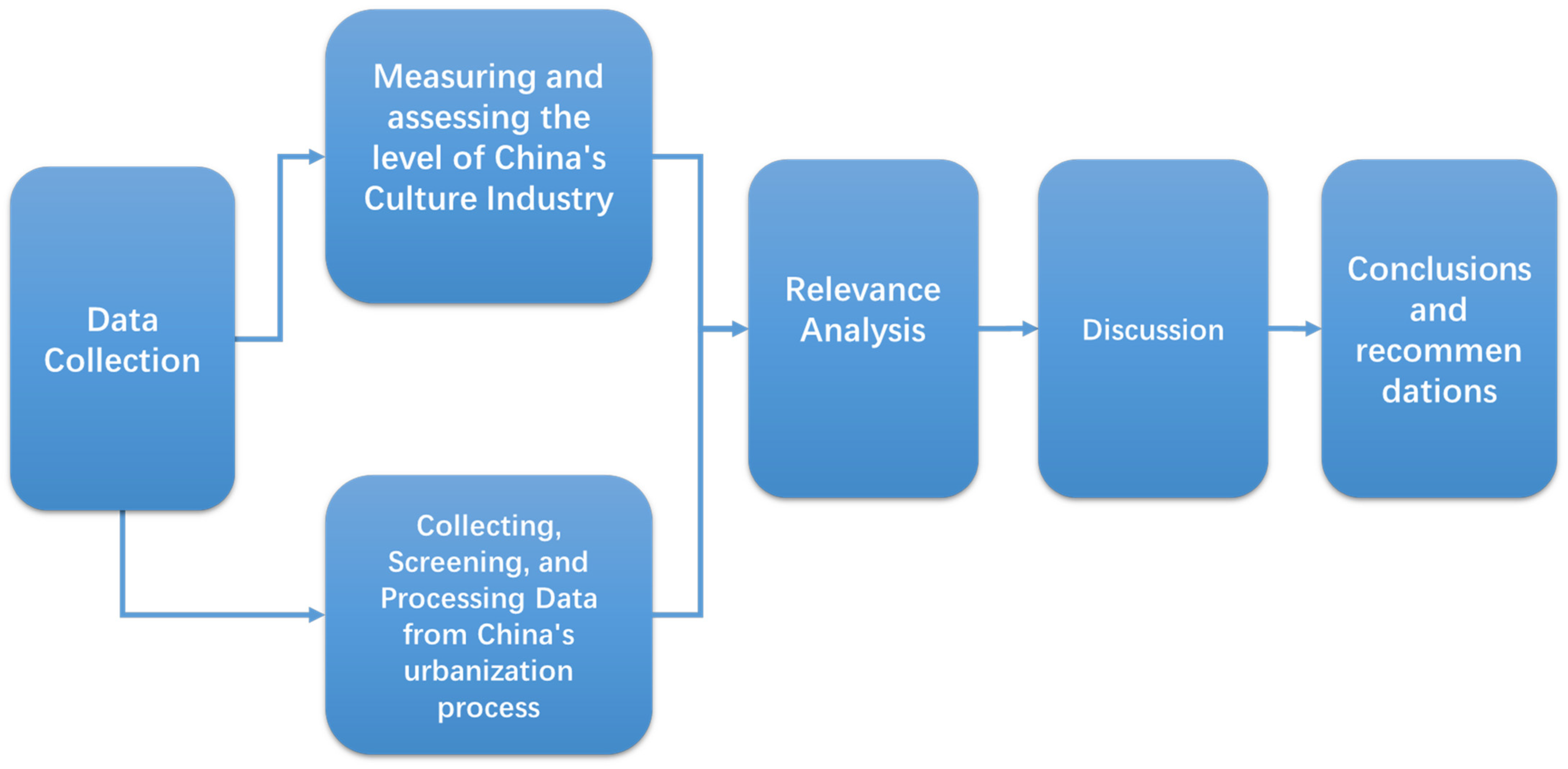

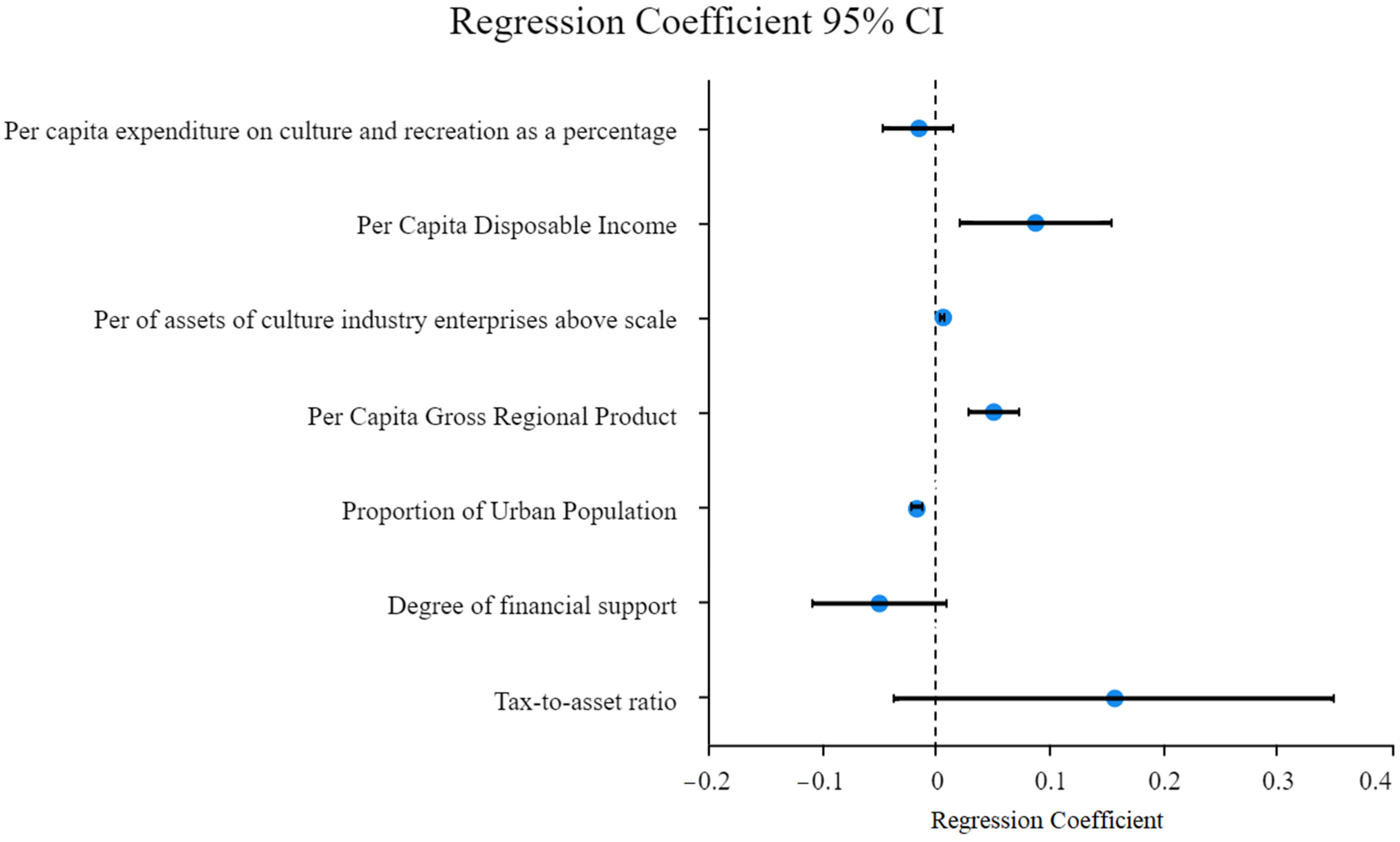




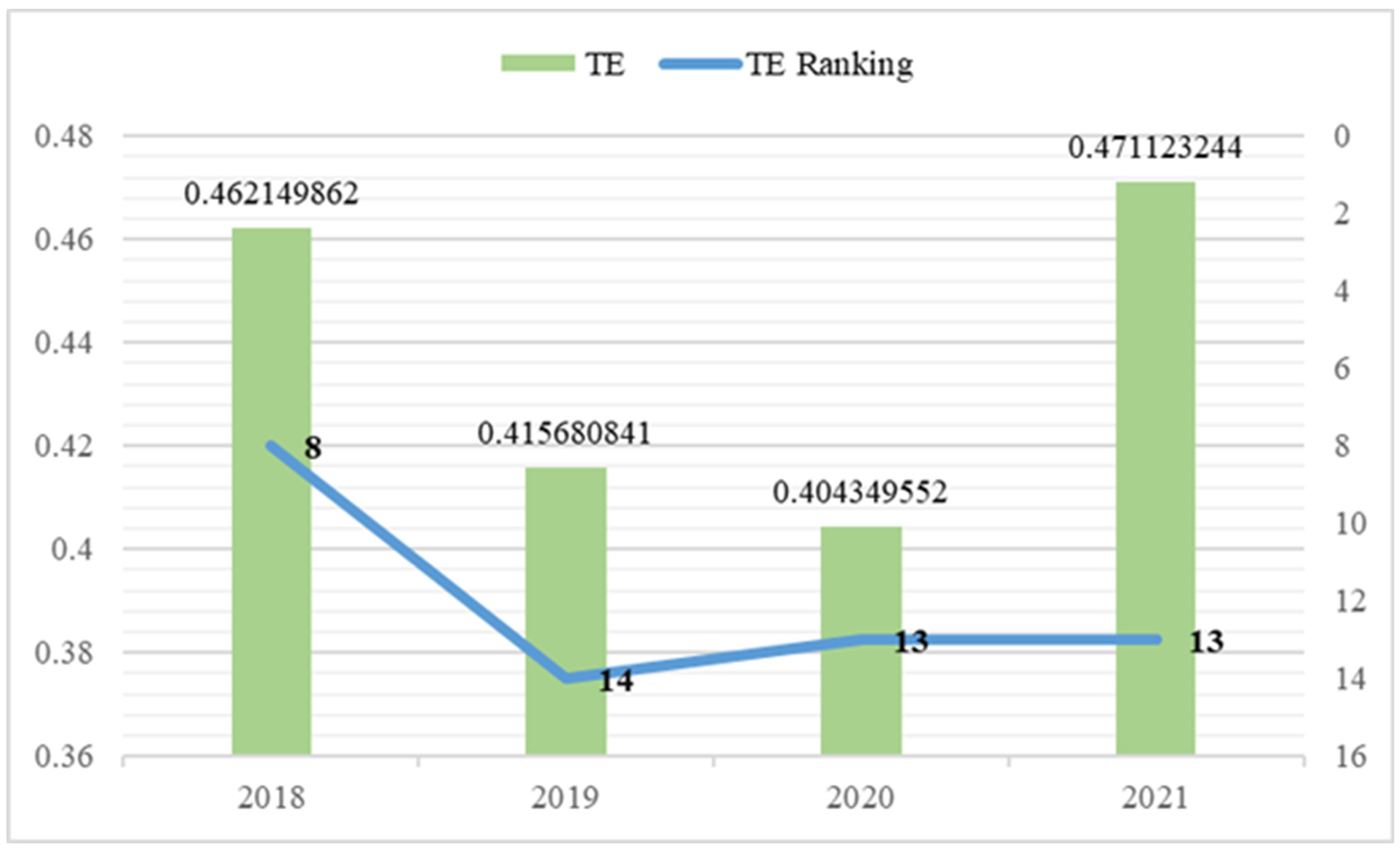

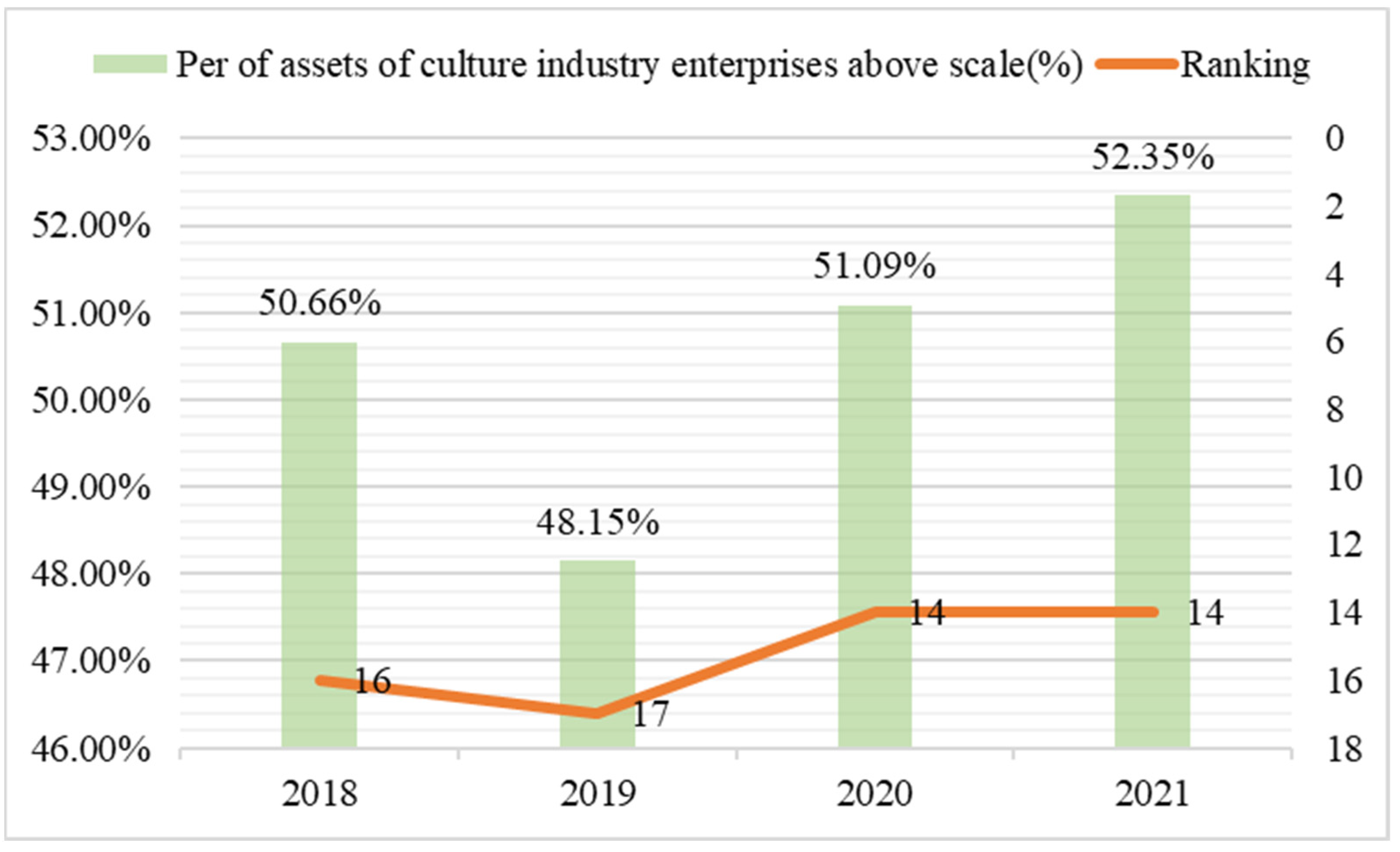
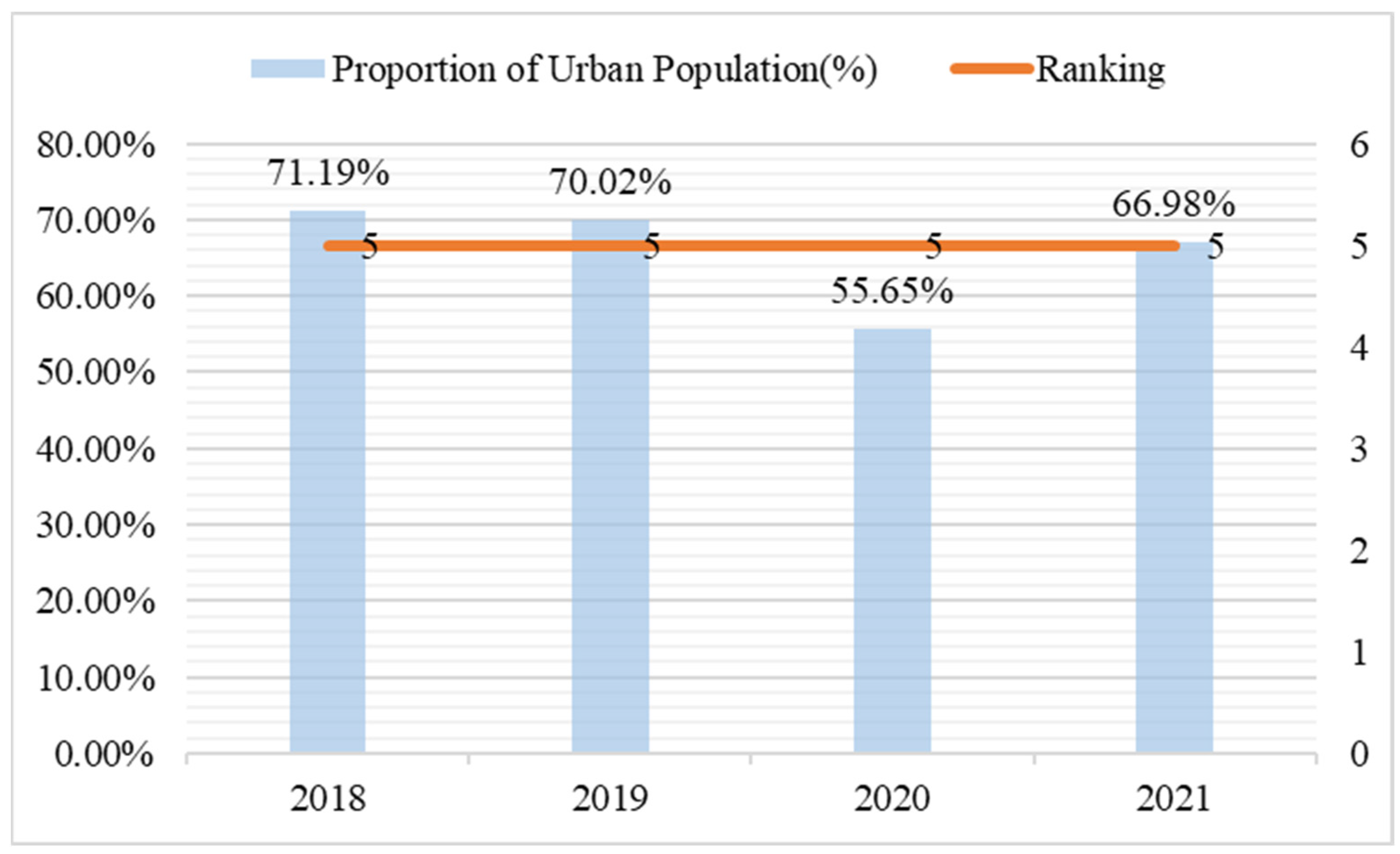
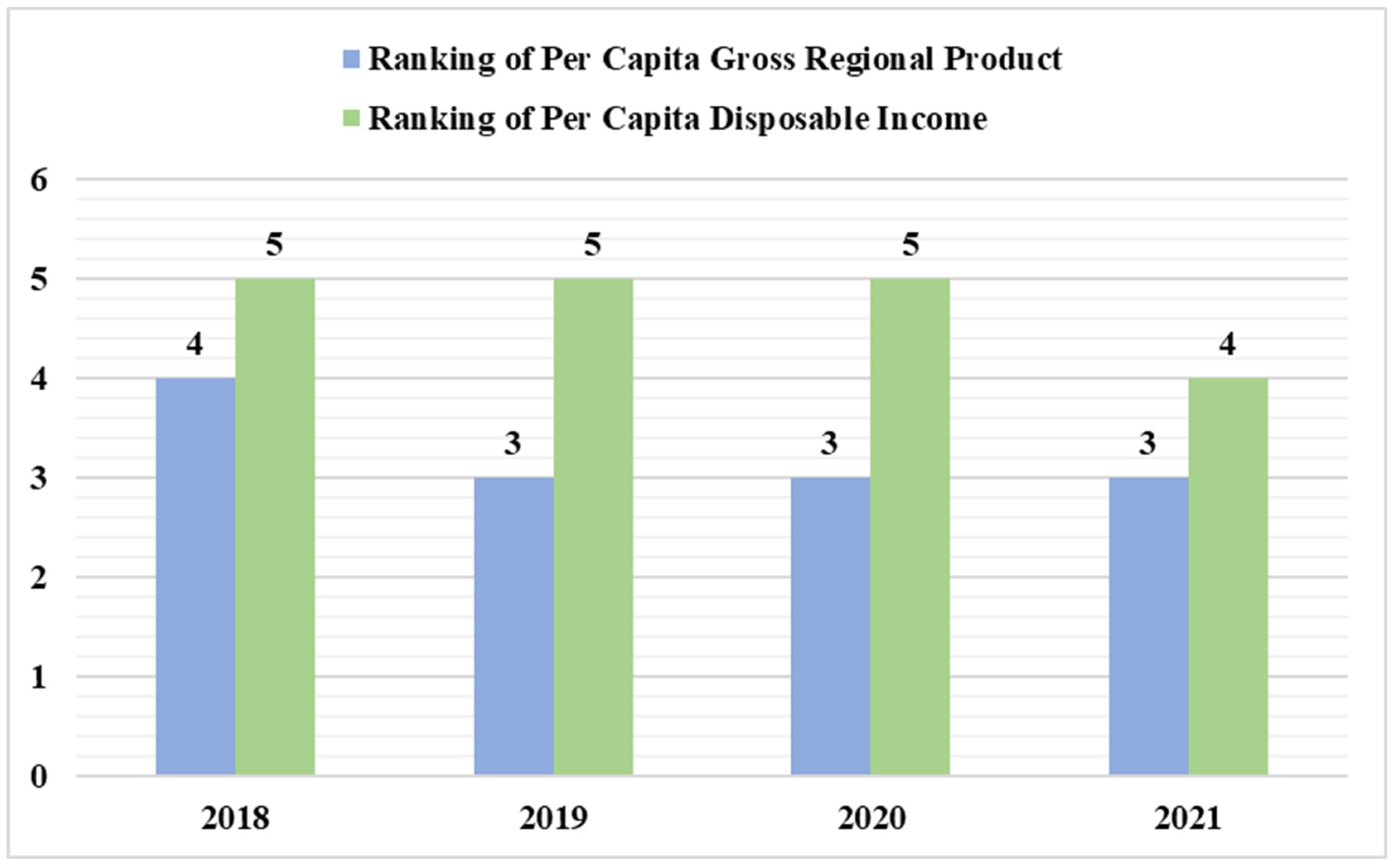
| Indicator Categories | Indicators |
|---|---|
| Input indicators | Number of Enterprises at Year-end |
| Total Assets at Year-end | |
| Engaged Persons at Year-end | |
| Output indicators | Total Revenue |
| Mean Value of TE | Mean Value of PTE | Mean Value of SE | Number of CRS | Number of DRS | Number of IRS | |
|---|---|---|---|---|---|---|
| 2018 | 0.36318725 | 0.445118065 | 0.886811874 | 6 | 20 | 5 |
| 2019 | 0.39392756 | 0.480749075 | 0.896238444 | 7 | 19 | 5 |
| 2020 | 0.382403556 | 0.45110521 | 0.896912632 | 7 | 19 | 5 |
| 2021 | 0.440109884 | 0.551576374 | 0.866256087 | 8 | 18 | 5 |
| Censor Data Samples | ||||
|---|---|---|---|---|
| Sample Size | Uncensored | Left-Censored | Right-Censored | |
| Number | 124 | 124 | 0 | 0 |
| Percentage | 100% | 100.00% | 0.00% | 0.00% |
| Model | −2× log-Likelihood | Cardinality | df | p | AIC | BIC |
|---|---|---|---|---|---|---|
| Intercept Distance | −18.686 | −18.686 | ||||
| Final Model | −138.275 | 119.588 | 7 | 0.000 | −122.275 | −99.712 |
| Regression Coefficient | |
|---|---|
| Distance | 0.761 ** (6.558) |
| Per capita expenditure on culture and recreation as a percentage (%) | −0.017 (−1.053) |
| Per capita disposable income (10,000 CNY) | 0.086 * (2.534) |
| Per of assets of cultural industry enterprises above scale (%) | 0.004 ** (3.624) |
| Per capita gross regional product (10,000 CNY) | 0.050 ** (4.353) |
| Proportion of urban population (%) | −0.017 ** (−7.310) |
| Degree of financial support (%) | −0.051 (−1.666) |
| Tax-to-asset ratio (%) | 0.156 (1.578) |
| log (Sigma) | −1.976 ** (−31.126) |
| likelihood ratio test | χ2 (7) = 119.588, p = 0.000 |
| McFadden R2 | −6.400 |
| Implicit Variable: TE | |
| TE | PTE | SE | Return of Scale | |
|---|---|---|---|---|
| 2018 | 0.46215 | 0.645335 | 0.716139 | DRS |
| 2019 | 0.415681 | 0.5507 | 0.754823 | DRS |
| 2020 | 0.40435 | 0.566045 | 0.714342 | DRS |
| 2021 | 0.471123 | 1 | 0.471123 | DRS |
Disclaimer/Publisher’s Note: The statements, opinions and data contained in all publications are solely those of the individual author(s) and contributor(s) and not of MDPI and/or the editor(s). MDPI and/or the editor(s) disclaim responsibility for any injury to people or property resulting from any ideas, methods, instructions or products referred to in the content. |
© 2024 by the authors. Licensee MDPI, Basel, Switzerland. This article is an open access article distributed under the terms and conditions of the Creative Commons Attribution (CC BY) license (https://creativecommons.org/licenses/by/4.0/).
Share and Cite
Zhang, W.; Zhang, R.; Zou, Y. Urbanization and Cultural Industry Correlation: An Empirical Analysis from China. Sustainability 2024, 16, 6807. https://doi.org/10.3390/su16166807
Zhang W, Zhang R, Zou Y. Urbanization and Cultural Industry Correlation: An Empirical Analysis from China. Sustainability. 2024; 16(16):6807. https://doi.org/10.3390/su16166807
Chicago/Turabian StyleZhang, Wen, Rong Zhang, and Yuntao Zou. 2024. "Urbanization and Cultural Industry Correlation: An Empirical Analysis from China" Sustainability 16, no. 16: 6807. https://doi.org/10.3390/su16166807
APA StyleZhang, W., Zhang, R., & Zou, Y. (2024). Urbanization and Cultural Industry Correlation: An Empirical Analysis from China. Sustainability, 16(16), 6807. https://doi.org/10.3390/su16166807












